Pump Handbook by Igor J. Karassik, Joseph P. Messina, Paul Cooper, Charles C. Heald - 3rd edition
Подождите немного. Документ загружается.


JAMES L. COSTIGAN
JOHN DRANE
9.187
SECTION 9.9
FOOD AND BEVERAGE
PUMPING
*Available from the International Association of Milk, Food and Environmental Sanitariums, Box 437, Shelbyville, IN
45176.
INDUSTRY STANDARDS_______________________________________________
Pumps for use in food, beverage, and pharmaceutical industries must meet various hygiene
standards.These standards define the materials of construction and the “cleanability” of the
pump. Unlike other industrial applications, pumps for the food and beverage industries must
meet rigid sanitation codes, know in the industry as the “3-A” Standards*. These standards
were originally established for the dairy industry by the following organizations:
1. The International Association of Milk, Food, and Environment Sanitarians.
2. The U.S. Public Health Service.
3. The Dairy Industry Committee, composed of representatives from the following:
• American Butter Institute
• American Dry Milk Institute
• Dairy and Food Industries Supply Association
• Evaporated Milk Association
• International Association of Ice Cream Manufacturers
• Milk Industry Foundation
• National Cheese Institute
• National Creameries Association
9.188 CHAPTER NINE
In the U.S., the 3A standards are widely enforced. They are recognized internation-
ally, but are not enforced to the same degree.The 3A standards are a self-certifying stan-
dard, and they consider design and construction features only. They do not require
microbiological testing for cleanability.
In Europe, the “Supply of Machinery (Safety) Regulations” (1992) defines the safety
and hygienic requirements for equipment to be used on agri-foodstuffs.This is legislative
and is not a voluntary standard. Compliance with these regulations enables the CE Mark
to be attached to the machine. Non-compliance means machines cannot be sold within the
European community (EC). The European Committee for Standardization (CEN) will pro-
duce a standard (TC 197) for pumps for food use, in support of the “Machinery Regula-
tions” that will eventually form the controlling standard for all pumps designed for food
use in the EC.
An independent group, formed mainly from users of sanitary equipment (European
Hygienic Equipment Design Group
—
EHEDG), has produced guidelines for all types of
equipment, including pumps. This group acts in an advisory capacity to CEN and other
standardization bodies. These guidelines are generally very onerous, but they are often
specified by end users of hygienic equipment.
The principle requirements of hygienic pumps are that the wetted parts should be com-
patible with the products being pumped, and that the pump can be easily cleaned, either
by dismantling or by clean-in-place (C.I.P.) processes. Externally, the pumps should be
smooth and free from crevices where dirt could lodge and bacteria or insects could flourish.
Emerging standards issued by the American Food and Drug Authority (AFDA) and
European Directives based on these standards specify suitable materials for contact with
foodstuffs. They also define any restrictions that may apply to them and test methods to
prove compliance. These standards are recognized internationally and are widely used.
PUMP DUTIES _______________________________________________________
Pumps are used for filling, emptying, transferring, dosing and mixing. They are also used
to convey the process fluid through plant items with a high resistance to flow, such as
membrane filters and heat exchangers. In general, pumping should not harm any solids
in the liquid, and delicate shear-sensitive products must be handled gently. The choice of
a particular pump depends on consideration of a number of factors. These include capac-
ity, delivery pressure, and suction conditions. The calculation of system pressure losses is
discussed in Section 8.1.
It is important to consider the viscosity of the liquid at the actual shear rate and tem-
perature appropriate for the system. Newtonian liquids have a constant viscosity with
shear rate (for example, glucose). Nonnewtonian liquids such as tomato ketchup have a
viscosity that is dependent on shear rate. Some liquids become less viscous with increas-
ing shear rate; these liquids are called thixotropic. Examples of a thixotropic liquid are
starch and molasses. Others, less commonly, become more viscous with increasing shear
rate; these liquids are called dilatant. An example of a dilatant liquid might be some candy
compounds. Most liquids also become less viscous with increasing temperatures.
The fact that viscosity changes with shear rate and temperature means that a careful
assessment must be made of all fluids that we intend to pump. This assessment would
normally produce three values of viscosity that must be considered in the pump and sys-
tem design.
1. Viscosity in the storage tank (low shear)
2. Viscosity in the pipe work (medium shear)
3. Viscosity in the pump (high shear)
A shear-sensitive material, which will degrade with work, would normally need a posi-
tive displacement pump with low shear characteristics, pump speed being selected accord-
ingly. If solids in the product are not to be damaged, a pump with suitable-sized spaces and
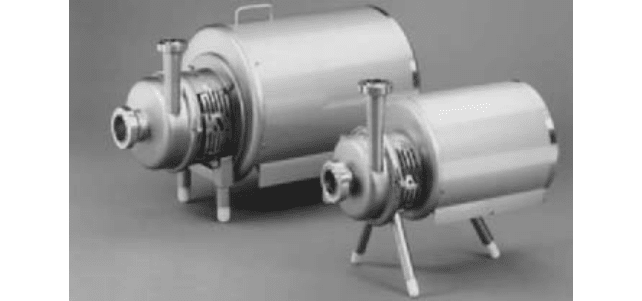
9.9 FOOD AND BEVERAGE PUMPING 9.189
FIGURE 1 Hygienic centrifugal pump (APV Fluid Handling)
cavities must be selected. In some cases, high shear rates will be advantageous to the process
(for example, mixing of emulsions) and the pump and system can be selected accordingly.
The chemistry of the liquid will determine the compatibility of the pump materials. The
viscosity of the process fluid and its rheological properties affects both the speed at which
the pump can run and also the friction losses to be expected within the system. The friction
losses will affect the power required to run the pump. Generally, the more viscous a prod-
uct, the slower the pump will need to run. If the product is very viscous, larger suction pip-
ing may be required, or in some cases, special enlarged inlets are used with auger
assistance.
If the product is abrasive or carries hard solids in suspension, again pump speed will
often need to be reduced to give economic life to pump components. Often, pumps with
resilient components or those that do not have fixed clearances are better suited for this
service. If, however, the solids in suspension are liable to settle at low speeds, speed must
be increased to keep the solids in suspension to protect component life.
The product temperature may affect the suction performance capability of the pump.
Also, for high fluid pumping temperatures, the pump and pumping elements must be
selected to take account of differential expansion or contraction resulting from tempera-
ture variations. In some cases, pump performance is limited because of liquid properties.
PUMP TYPES ________________________________________________________
Food and beverage pumps are divided into two generic types: rotodynamic and positive
displacement. Both types are widely used in the food and beverage industries.
Rotodynamic Pumps Rotodynamic (centrifugal) pumps are widely used in hygienic
applications (Figure 1) because they are simple and inexpensive, they give a smooth deliv-
ery, and they are relatively easy to clean. They are, however, limited by viscosity that will
greatly reduce pump efficiency above about 500 centipoise, generally regarded as the lim-
iting viscosity. As the pumps rely on speed of rotation to generate head, there are fairly high
shear rates within the pumping elements that affect shear-sensitive products.Also, because
it is not self-priming, it has a limited ability to handle entrained gases and vapors. A posi-
tive feature of centrifugal pump designs is that the performance varies according to the sys-
tem operating conditions to which it is subjected. Unlike a positive displacement pump, the
discharge of a centrifugal pump can be partially or fully closed without over-pressurizing
the pump.
9.190 CHAPTER NINE
ADVANTAGES
These pumps are simple; they are of generally robust construction; pumps
are easy to clean in place; pumps cannot be over-pressurized against a closed valve; they
can be connected in series for increased pressure; and they can be connected in parallel
for increased flow.
DISADVANTAGES
These pumps typically are not self-priming; they are generally limited to
about 500 centipoise viscosity; they are limited ability to handle fluids that are shear-
sensitive; and they have a limited ability to handle high percentages of entrained gases.
Positive Displacement Pumps Positive displacement pumps are used in processes
where viscosity limits the capabilities of a centrifugal pump or where the process needs
to be versatile and the batches vary. They are normally self-priming and can handle
gaseous products. However, all positive displacement pumps require pressure relief sys-
tems to prevent damage to the pump or system if a valve is closed or the outlet blocked.
Many types of positive displacement pumps are available and they are normally split
into two groups
—
rotary and reciprocating, the reciprocating type needing a valving sys-
tem to be able to operate. Valves increase shear rates and are susceptible to wear and
blockage.
Gear Pumps
ADVANTAGES These pumps are self-priming; there is uniform discharge with little puls-
ing; the pumps are reversible; due to small clearances, little flow variation with change of
viscosity or pressure.
DISADVANTAGES They can only pump clean fluids due to fine clearances and rubbing gear
teeth; they cannot run dry; they need close tolerances to operate, so fits and alignment
are critical.
Lobe Rotor Pumps (Figure 2)
ADVANTAGES These pumps can run dry for short periods as rotors have clearance, but run-
dry time is limited by the seals; pumps can self-prime on low lifts; pumps can handle solids
in suspension; there is little change of product velocity as it passes through the pump, so
the pump has good net positive suction head (NPSH) performance, once primed; pumps
can generally handle viscous materials; pumps are usually reversible.
DISADVANTAGES
Fixed clearances can mean rapid performance degradation because of
abrasive wear; pump has two shafts and associated shaft seals; suction lift limited at low
speed/viscosity due to clearance of rotors.
Flexible Impeller Pumps (Figure 3)
ADVANTAGES Pumps are generally self-priming; pumps create relatively low pressure pul-
sations while pumping; pumps are reversible; pumps can handle gaseous fluids and flu-
ids with some solids in suspension; pumps are easily cleaned.
DISADVANTAGES Pumps cannot run dry; pumps are only suitable for low pressure appli-
cations; pumps are not suitable for abrasive services.
Progressive Cavity Pumps (Figures 4 and 7)
ADVANTAGES These pumps are self-priming; they exhibit uniform discharge with little pul-
sation; they are reversible and can handle gaseous fluids; they can handle solids in sus-
pension and abrasives and can handle shear-sensitive fluids with little damage.
DISADVANTAGES The pumps cannot run dry.
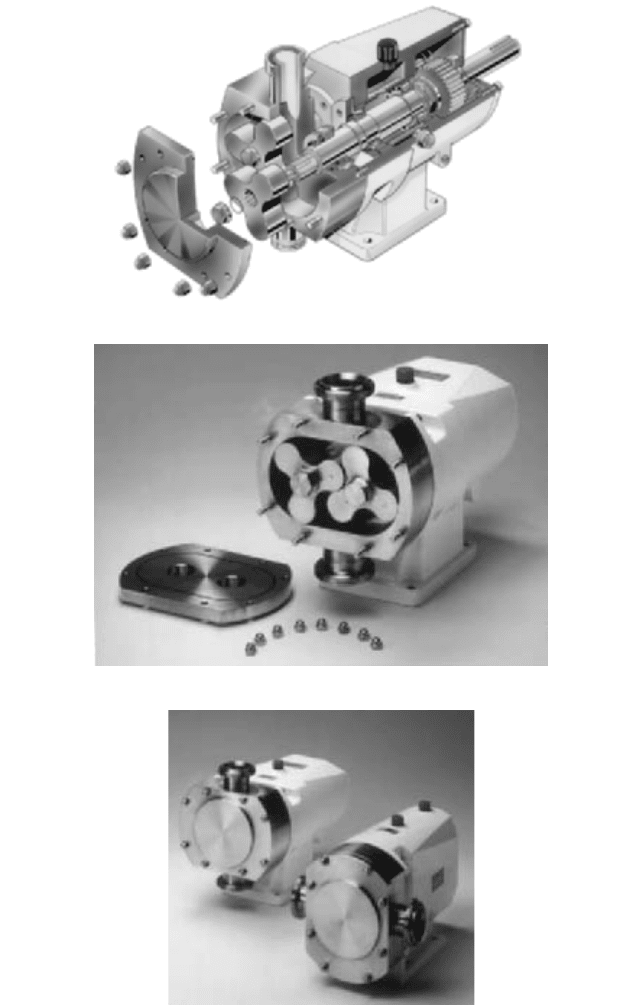
9.9 FOOD AND BEVERAGE PUMPING 9.191
A
B
C
FIGURE 2A through C Rotary lobe pumps (Alfa Laval Pumps, Ltd.)
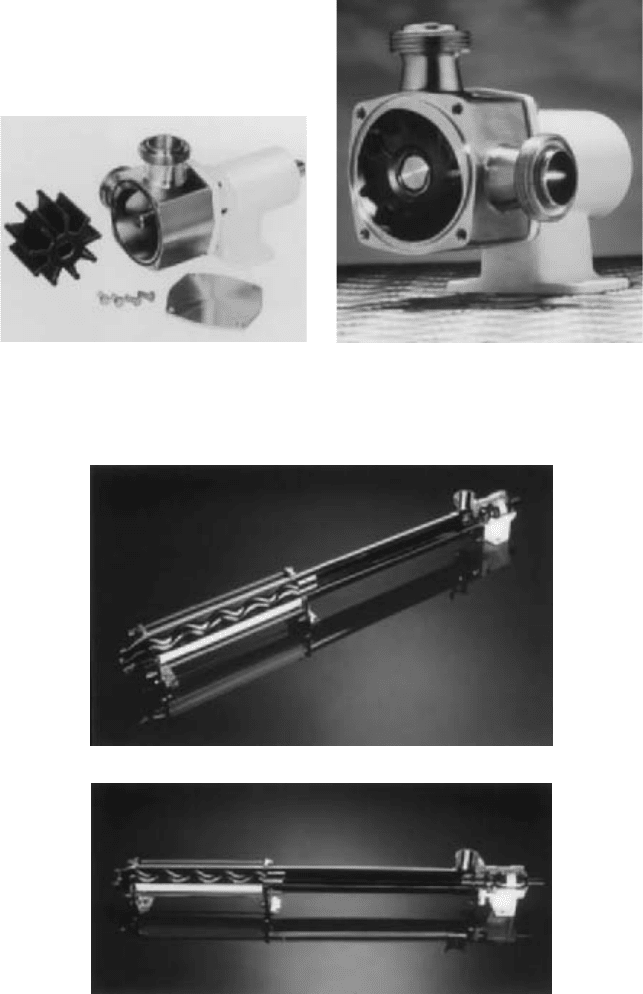
FIGURE 3A and B Flexible impeller pumps (ITT/Jabsco).
9.192 CHAPTER NINE
A
B
FIGURE 4A and B Hygienic progressive cavity pumps (Mono Pumps, Ltd.)
AB
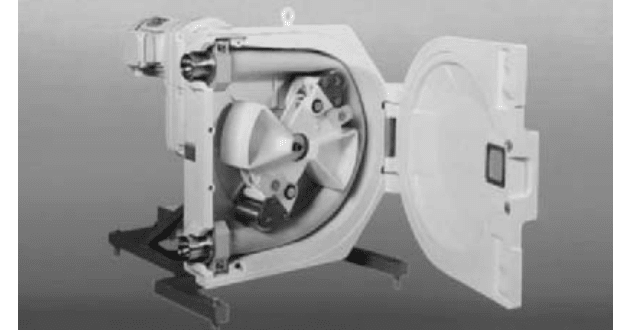
9.9 FOOD AND BEVERAGE PUMPING 9.193
FIGURE 5 Hygienic peristaltic pump (Watson-Marlow, Ltd.)
Peristaltic Pumps (Figure 5)
ADVANTAGES
Pumps are self-priming; they can run dry and are reversible; they can han-
dle gaseous fluids and can pump abrasive material and solids in suspension; they have
only one contact part with no seals.
DISADVANTAGES Tube failure means loss of product; at low rotational speeds, pulsation can
be a problem.
Piston Pumps
ADVANTAGES Pumps may be used for very precise dosing; pumps can handle high pressures.
DISADVANTAGES Pumps are not reversible; they need valves to operate; and they gener-
ally have pulsing flow.
Diaphragm Pumps
ADVANTAGES Pumps can run dry for short periods; they are fairly easily cleaned; and they
have no glands.
DISADVANTAGES Pumps are not reversible; they need valves to operate; and they have puls-
ing flow.
Mechanical Seals Pumps in the food and beverage industries are almost totally fit-
ted with mechanical seals (see Figure 6).These seals must be simple in construction and
designed in such a way as to facilitate cleaning. Cleaning in place (C.I.P.) is a frequent
requirement, and mechanical seals for these pumps are specifically designed for this
purpose.
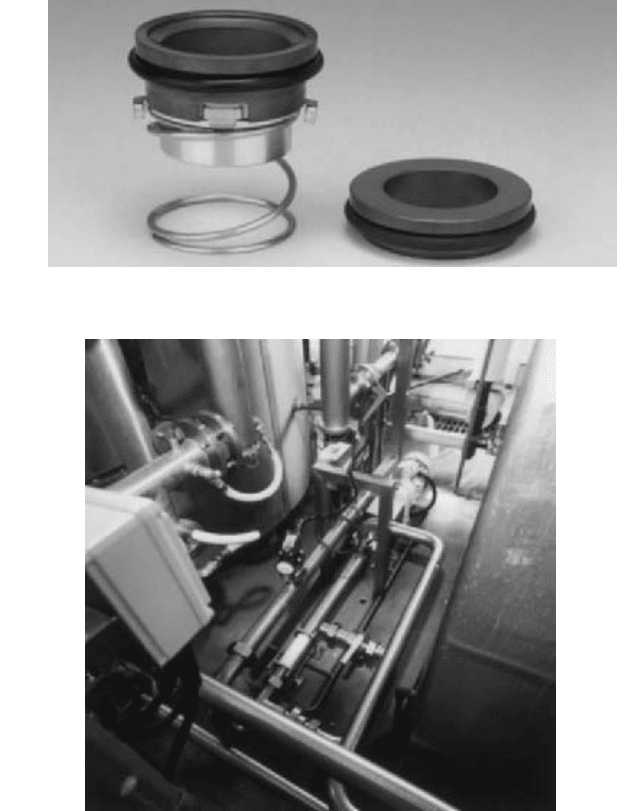
9.194 CHAPTER NINE
FIGURE 6 A hygienic mechanical seal (Roplan, Ltd.)
A
FIGURE 7A through C Typical installations of a progressive cavity hygienic pumps (Mono Pumps, Ltd.)
Pump Drives Standard electric motors, usually totally enclosed and fan-cooled, are used
throughout the industry. A stainless steel casing is sometimes used to enclose the motor
and simplify external cleanability. Pump units must be either grouted to the floor or
mounted at least 2 in (50mm) above the floor to enable cleaning and eliminate any build-
up of debris.
Figures 7A, B and C show typical installations of progressive cavity hygienic pumps.
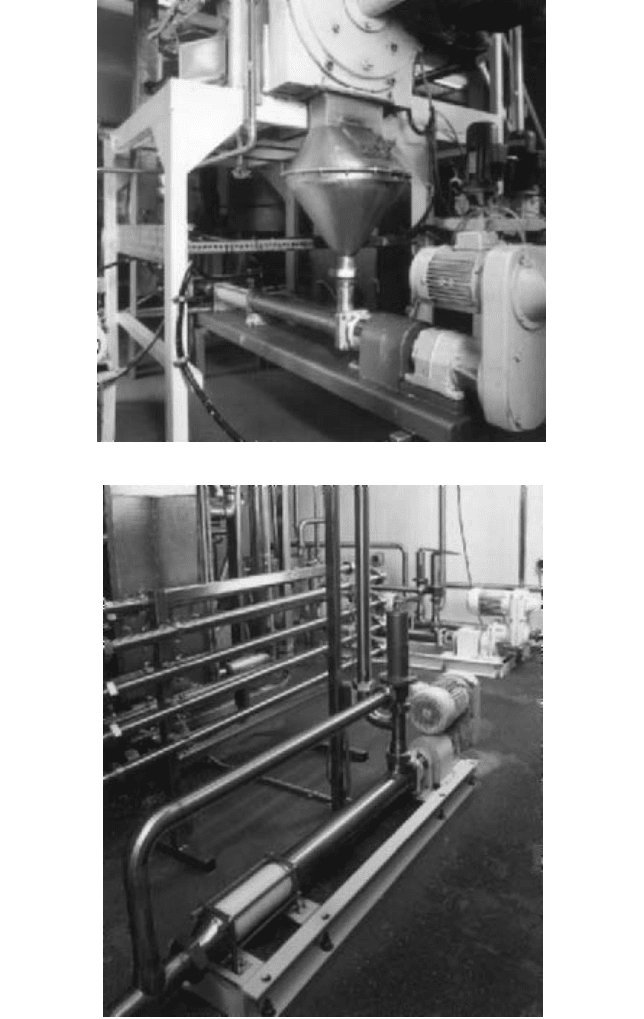
9.9 FOOD AND BEVERAGE PUMPING 9.195
B
C

W. D. HAENTJENS
9.197
SECTION 9.10
MINING
It might be asked why pumps used in mining services receive a separate classification
when the types involved do not differ in principle or in general appearance from those
used in fresh-water service. The answer is the need for utmost reliability and an ability to
withstand both corrosive and abrasive waters. Not all mine waters are corrosive, but
almost all mine waters from active mines are abrasive because of the suspended solids
from the mining operations. Much can be done to limit the amount of solids handled, but
the solution generally requires a compromise based on economics. Removal of most coarse
solids is usually justified but removal of fine solids is generally impractical. Thus, a heavy-
duty pump has evolved that warrants the classification of mine pump.
PUMPING CONDITIONS AND PUMP TYPES_______________________________
Pumping conditions in mining services can be determined from a consideration of the
types of mines and the material being mined. For example, the broadest category would be
a division between open-pit and underground or deep mines. Open pit mines seldom
exceed 600 ft (183 m) in depth so the pumping heads generally are not much greater than
this unless very long discharge lines are required. For many open-pit mines, the greatest
pumping load does not result from groundwater but from rainfall. Unless a certain
increase in water level can be tolerated at the bottom of the pit, the maximum rainfall rate
and the drainage area involved will determine the required pumping capacity.
As mining progresses, the pumps generally must move with the operator. This suggests
the use of barge-mounted vertical pumps.A practical cost-effective way of achieving dewa-
tering under this scenario is the use of a pond system with barge-mounted vertical can-
tilevered shaft pumps. Barge mounting adds a great deal of flexibility. Simple barges, as
in Figure 1, illustrate the simplicity of this mounting. Except for occasional greasing of the
bearings, there is little maintenance, as these pumps do not require a stuffing box or
